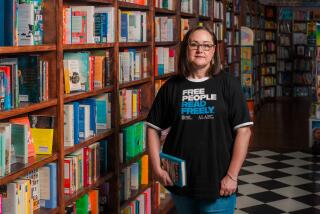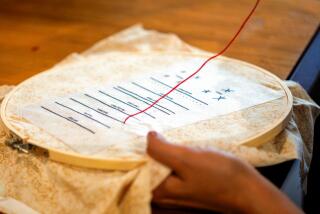HOBBIES : Bookbinders’ Craft Keeps Pages Turning
If your family Bible looks like it’s been through flood, fire and an attack of locusts, you could take it to Donald Beswick, Ventura County’s only full-time bookbinder. For about $80, he’ll repair the torn cover, replace the fraying spine and put on a new leather binding.
But, if you’ve got some patience and you’re good with your hands, you could learn to do it yourself.
Beswick has organized the Ventura County Society of Bookbinders and Book Restorers, a good-natured group that gets together to demonstrate bookbinding techniques, badger each other for wasting wax paper and swap war stories about the time they restored a really dilapidated volume.
Experts and novices are welcome.
“The mother society in England is called the Society of Bookbinders and Book Restorers, so I merely added Ventura County,” says Beswick, to explain the group’s unwieldy name.
Beswick, who moved from England to Camarillo four years ago, started the society last fall. The group, which has about eight members, meets on the last Wednesday of every other month. They’re trying to revitalize a craft that, according to Beswick, involves “as much engineering as a bridge.”
“I hope there’s going to be a resurgence in bookbinding,” Beswick said. “I hate the thought of books disintegrating and being lost.”
In March, the society--actually, only four members showed up--met at the home of James Owens, a Moorpark attorney who does bookbinding on the side. Owens repairs many of the volumes at Thorn Books, the Moorpark bookstore that his wife owns.
Although they dress casually, in shirt sleeves and tennis shoes, the society members run their meetings with lighthearted formality.
First they assembled in the Owens’ living room to discuss future plans. In May, the group will learn “marbling,” making a marble-like pattern on the inside cover of the book.
Then Owens turned to the three other members present and said, “Anything else at the meeting session or shall we proceed with the demonstration?”
Onward, they went, to the Owens’ chilly garage for a leather- binding demonstration.
The process takes about a week to complete, because a book must be left to dry at several stages. But Owens did the demonstration in an hour using the Julia Child method, putting the souffle in the oven and pulling out the puffed-up version five seconds later.
Owens used about a half-dozen books at various stages of repair.
He began with a book whose cover had fallen off. His first task was to remove the spine with a razor--no easy task. To facilitate the process, he used a book with a “loose spine,” which is much easier to remove than a “tight spine.”
(With a tight spine, the leather is glued directly onto the back of the book, making it difficult to remove the leather in one piece. With a loose spine, the leather is glued to a hollow tube affixed to the back of the book, so the binder merely has to slice through the tube.)
Beswick wasn’t going to let Owens off easy for using the loose spine.
“Coward,” Beswick said.
For the next hour, Owens went through about two dozen steps that involved pasting, cutting, folding, sewing and pressing. He performed each step carefully, making sure to avoid “unsightly bulges.”
For some steps he used homemade bookbinder’s paste and for others he used “PVA,” or polyvinyl acetate, otherwise known as Elmer’s glue.
The society members, however, insist on the technical name. “In the trade we call it PVA,” Owens said.
Toward the end of the demonstration, Owens affixed a binding of sheep leather, which had been dyed black. He then “mummified” the book--wrapped it with an Ace bandage--to make sure the leather would adhere to the spine.
When Owens finished, the novice bookbinders said they were eager to learn more.
“I like puzzles, and I view this as a puzzle,” said Rod Lang, an insurance company manager who lives in Newbury Park. “I like the intricacy of putting it together.”
Lang has been learning the craft from Beswick, but Beswick is selective about his students.
“I wouldn’t take on anyone as a pupil if they weren’t as interested in the inside of the book as the outside,” Beswick said. “Books are meant to be read.”
More to Read
Sign up for our Book Club newsletter
Get the latest news, events and more from the Los Angeles Times Book Club, and help us get L.A. reading and talking.
You may occasionally receive promotional content from the Los Angeles Times.









